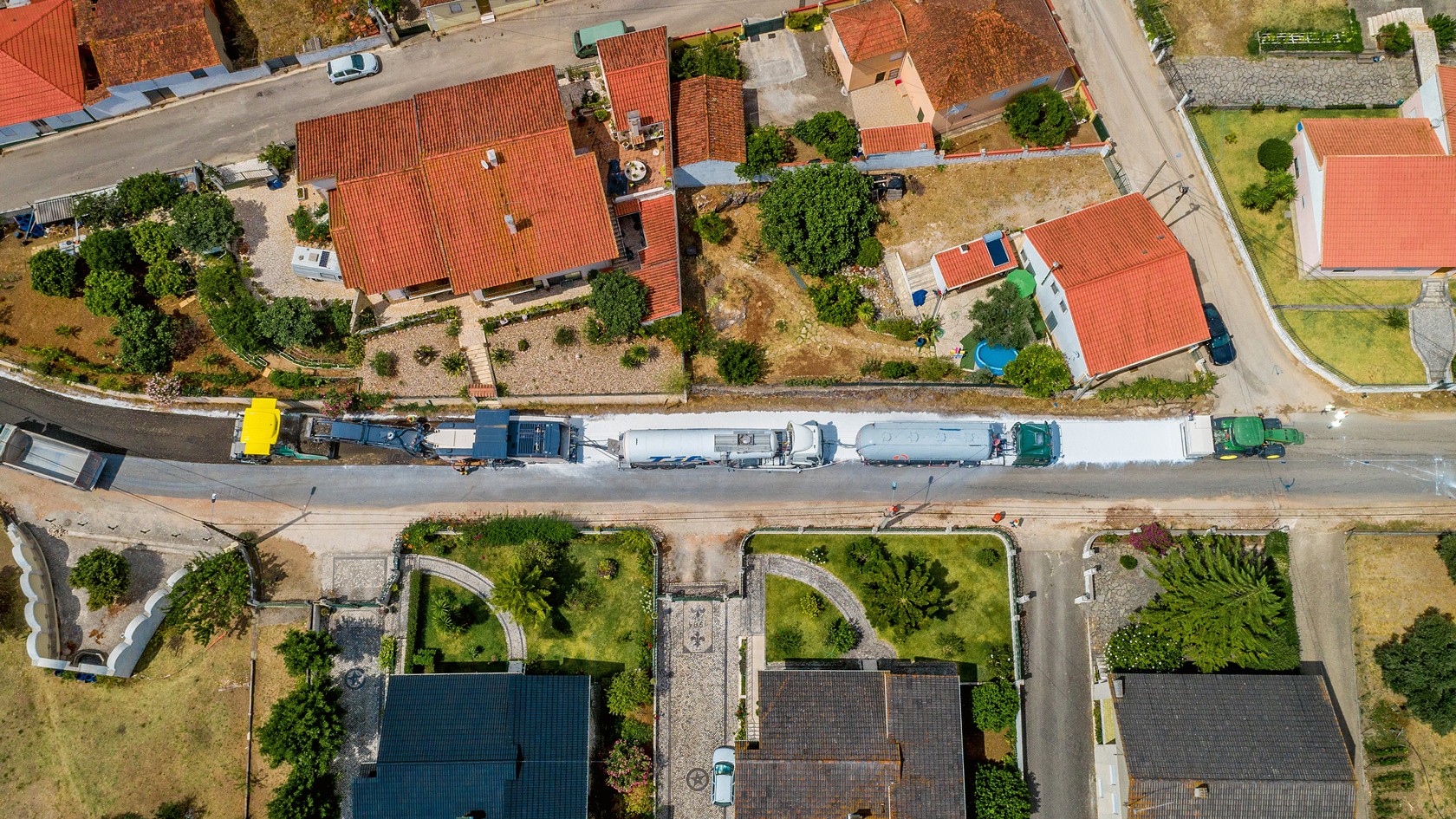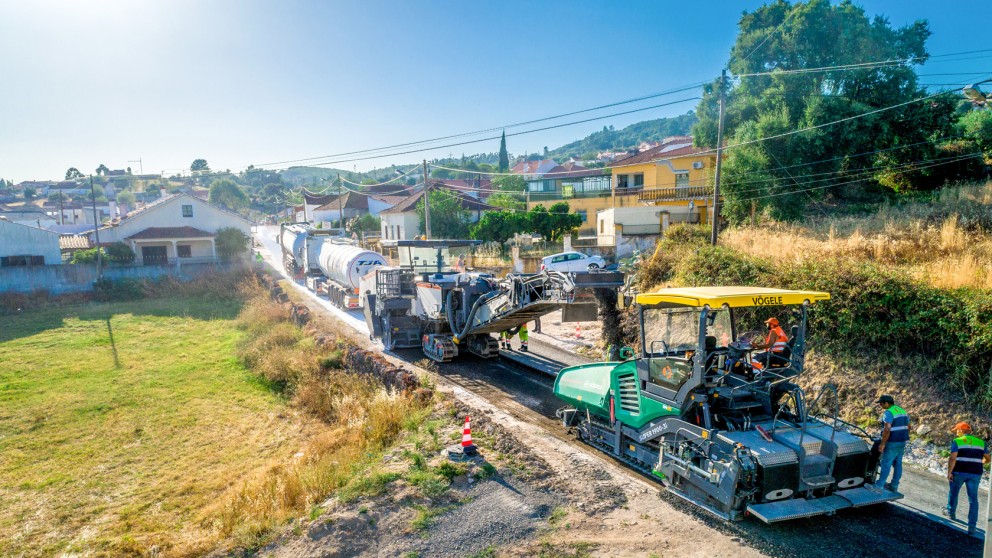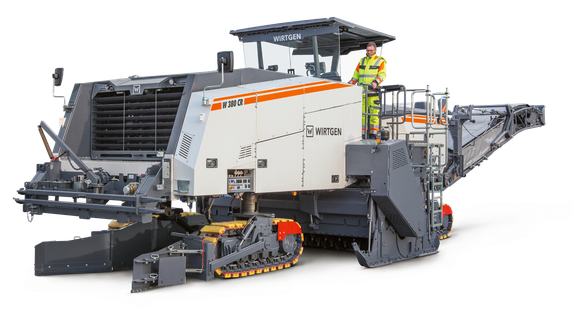

Eco-friendly road rehabilitation with cold recycling train in Portugal
Trunk road ER 361 through the town of Monsanto, about 100 km north of Lisbon, required 2.7 km of structural rehabilitation in both directions. The authority awarding the contract, Infrastructuras de Portugal, had planned some 12 weeks for the repair. Road construction experts from Pragosa used the cold recycling process to complete the job in just 4 days.
WIRTGEN W 380 CR cold recycler rehabilitates the road surface in record time
The heart of the cold recycling train is the new Wirtgen W 380 CR, which made its debut for Pragosa on this construction site. It is capable of recycling the old layers of the road in just one pass. A Vögele paver was responsible for paving true to line and level, and several Hamm rollers carried out the final compaction.

Milling, processing, paving and compacting – eco-friendly road rehabilitation with technology from the WIRTGEN GROUP

Before construction work began, we lined up all the machines in the construction company’s yard and briefed the entire construction site crew on the machine technology and techniques. Professionally prepared for the project requirements, the crew and WIRTGEN GROUP machines worked together perfectly and the project was thus completed efficiently and with excellent results. I have been all over the world and seldom worked with such a skilled and well-practised team.
Mike Marshall, Recycling expert at WIRTGEN GmbH
Time savings key to the success of cold in-place recycling process
Time is another factor in the success of cold in-place recycling, as this application is called. Shortening the duration of the project from 12 weeks to 4 days was only possible because almost no material had to be transported. The actual construction site planning had envisaged that both lanes would be excavated to a depth of 54 centimetres and rehabilitated from scratch. This would have resulted in 7,500 m³ of material that would have had to be transported away from the construction site and replaced with new material. Replacing the material, including all the associated work, resulted in the planned construction duration of 12 weeks. Cold in-place recycling eliminates the need to replace existing material, as it can be reused right on the construction site. By adding lime and foamed bitumen as binding agents and using all the existing materials, a new, high-quality construction material is produced on the spot. The new bitumen-stabilised material (BSM) serves as the new ‘backbone’ of the busy road, and is immediately fit for traffic again after completion of a construction section.
Flexibility thanks to adjustable working widths
The width of the lane varied between 2.75 metres and 3.25 metres on the construction site. The W 380 CR cold recycler was thus equipped with a milling drum unit with a working width of 3.2 metres instead of its standard unit with a working width of 3.8 metres. The innovative MCS system even made it possible to switch the units on the construction site.
The University of Minho was responsible for designing the mix for the new BSM layer and collecting samples of the existing road structure. In the process, they determined that the road bed still had enough bearing capacity that a BSM layer plus a new asphalt surface layer represented a long-lasting alternative to the conventional, cost-intensive process of building a new road. To produce the new BSM layer, 7 kg of lime per square metre needed to be added to the mix. The lime was applied directly to the old road surface before the mixing process. With its extremely precise spreading unit, a Streumaster SW 5 RC mounted to a John Deere tractor ensured that the lime was evenly distributed. The maximum spreading width of 2.5 metres required the spreader to make two passes to cover the CR’s working width of 3.2 metres. By carefully discharging the material at the right spreading width, the crew achieved a high degree of spreading accuracy, which kept costs as low as possible.

The rear-mounted SW 5 RC binding agent spreader precisely distributes the required amount of lime in front of the cold recycling train.
Cold recycling train with WIRTGEN W 380 CR cold recycler
The W 380 CR then milled 16 centimetres deep through the damaged asphalt surface layer into the binder course. “The working depth of the cold recycler was set to 16 centimetres in order to produce a BSM layer with sufficient bearing capacity,” says Mike Marshall. After adding only 2.6% foamed bitumen and water, the lime was mixed in directly. Using the down-cut method, the new homogeneous road bed was mixed from the existing material consisting of the surface course and parts of the binding agent with the aggregates. The enormous engine power of the CR paired with the highly efficient and powerful foamed bitumen spray bar allowed the machine to advance at 5 metres per minute. In the process, the CR produced around 320 tonnes of high-quality BSM mix per hour. “Foamed bitumen was selected as the binding agent. This offers numerous benefits in terms of processing capabilities and cost-effectiveness. In addition, cold processing significantly reduces carbon emissions,” explains Mike Marshall.
Paving with the VÖGELE paver
The flexibly adjustable conveyor of the W 380 CR transported the 320 tonnes of BSM into the hopper of the Vögele SUPER 1900-3i following behind it. At its maximum capacity of up to 900 tonnes per hour, the paver was able to work in a particularly fuel-efficient manner in ECO mode here. The TP2 extending screed with Vögele high-compaction technology that was used features a tamper and two pressure bars. It was responsible for thoroughly pre-compacting the surface and could be perfectly tailored to the properties of the recycled material thanks to the ability to adjust the speed and stroke. Ideal levelling systems paired with the compact design of the SUPER 1900-3i made it possible to follow the CR in the lane and pave the new lane true to line and level.
Compaction and sealing with HAMM tandem and pneumatic tyre rollers
The paver was followed by three Hamm road rollers to complete the construction project. An HD+ 110i tandem roller with a smooth drum was used to first seal and stabilise the perfectly paved layer. Two GRW 18 pneumatic tyre rollers were then used for final compaction. The impressive compaction performance of the Hamm rollers produced a seamless transition to the unmilled lane. The surface quality of the BSM layer was so good after only a few passes of the pneumatic tyre rollers that it was possible to open the lane to traffic. Even a fully loaded forklift truck operated by a local company was able to drive on the recycled roadway without damaging the surface.
After the cold recycling train, the final step was to apply the fog seal – a diluted bitumen emulsion used to protect the BSM layer from oxidation and weathering. The fog seal did not need to be removed before paving over with the new 5-centimetre-thick surface layer. It also serves as a binding agent and can withstand heavy traffic for a long time. In this case over five months, until the surface layer was finally applied.

The small town of Monsanto significantly benefits from the construction project. The construction work was completed in just four days, despite the road – with its tight bends and cobblestone driveways – posing quite the challenge.
Using conventional methods, rural road ER 361 would have been impassable at this point for 12 weeks, meaning that residents and businesses would have had to reckon with major problems and delays. Thanks to cold in-place recycling, the houses were only separated from the road for half an hour before everything went back to normal. No holes from excavators, no barriers – it was even sufficient to only close the lane that was being worked on.

Foreman Pedro Silva from construction company Pragosa and WIRTGEN recycling expert Mike Marshall (left) agreed that cold in-place recycling with the W 380 CR is extremely fast and economical.
Cold in-place recycling – the state-of-the-art road construction method
The environmental benefits of cold recycling are abundantly clear. According to Pragosa, it saved around 98% of the carbon emissions compared to the conventional construction method. This was primarily due to the fact that the construction material was reused on site, which otherwise would have had to be transported to and from this construction site by truck – in around 1,500 separate trips. In addition, there were no landfill costs for disposal and mining costs for the new material. In other words, using this method also conserved natural resources and significantly cut costs.

Tandem roller with two vibrating roller drums
| Weight | 10,965 kg |
| Drum width | 1,680 mm |
| Exhaust emissions category | EU Stage IIIA / EPA Tier 3 |
Tandem roller with vibration and oscillation drum
| Weight | 10,615 kg |
| Drum width | 1,680 mm |
| Exhaust emissions category | EU Stage IIIA / EPA Tier 3 |
